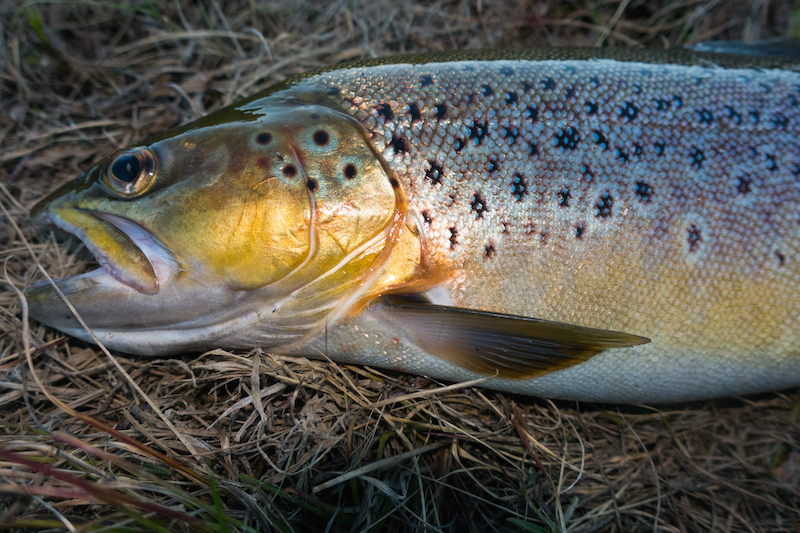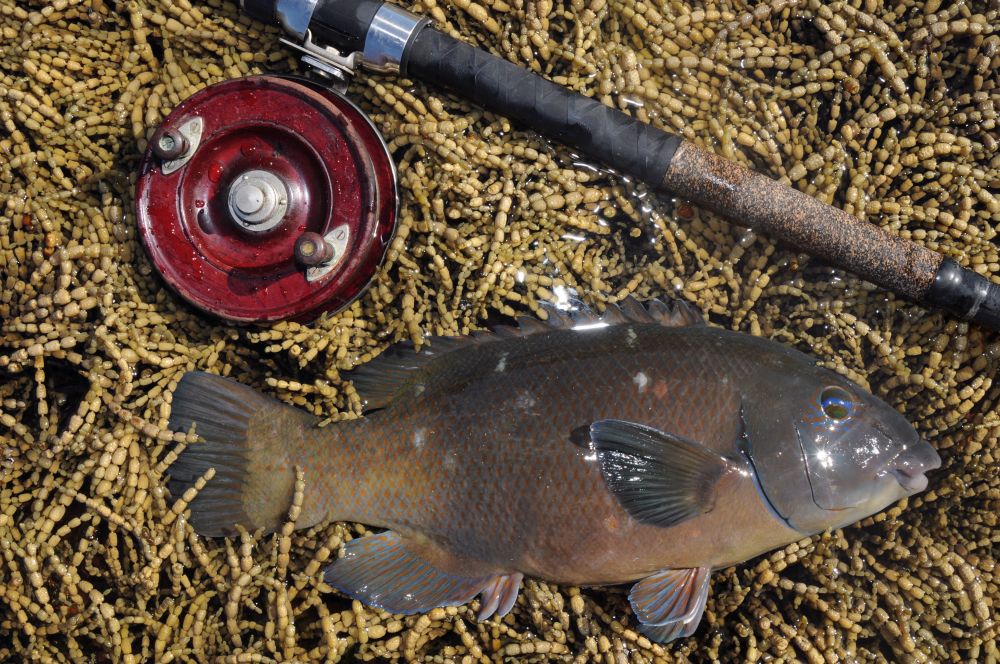
THERE’S something special about fishing the NSW high country, especially when there are some big and aggressive trout to be caught. Mick Fletoridis reports.
UP until recently, it had been 20 years or more since I’d walked the tussock banks of Tantangara Dam in the NSW Snowy Mountains. This alpine impoundment that forms an integral part of the Snowy hydro-electric scheme had provided great experiences: long weekends camped out with mates, four-wheel-driving boggy tracks, chasing wild trout in the dam and late in the season the tiny winding stream, Nungar Creek, which often held surprisingly big brown trout. So when I recently got a chance to revisit Tantangara at the suggestion of good mate and fly fishing gun, Dave Longin, I jumped at it.
According to Dave, the dam’s level was high for the first time in a long time following regular solid rainfall and the thaw of a bumper snow season. As it turned out, Dave was spot on. On the drive in we got the first view of the water through stands of alpine ash that line either side of the dirt road in. From Dave’s campervan Stumpy – with his tinny Cupcake in tow – it was obvious Tantangara’s water level was well up. Thanks to a gusty nor-wester, water was lapping high up into fresh grass and shrubs. It looked very fishy.
After messing around to find a suitable camp site – due to the closure of other access roads around the lake the eastern shore was well populated with mid-week campers – we launched Cupcake. That took a lot longer than it should’ve as another fisho had parked his car and trailer in the middle of the only turn-around point on the ramp road. With the boat finally in the water and the camper levelled on a suitable site on the lake bank, we hit the water for the last hours of light. Dave drove us across to the dam’s western side in the hope of some respite from the icy wind – it was late October but the temperature was still in single digits. A band of four or five wild brumbies looked at us quizzically as we climbed out of Cupcake and organised fly gear.
Wild times
With his 13.5 foot double hander rod pre-rigged, Dave was well into a trout before I’d even tied on a fly. As it turned out the fish was a chunky silver brown with a bulging stomach. The reason for the grotesque gut became clear as a pile of earthworms spewed out of the trout’s mouth. Dave kept it and an autopsy revealed its stomach was chock-a-block with earthworms – no doubt a result of the lake’s rapidly rising waters flooding long dry ground. Interestingly, we later had a chat to another camper whose mate caught a trout on the troll. When cleaning the fish he discovered it had eaten a small snake, variety unknown. Long wriggling things were definitely on the Tantangara trout’s menu.
We went on to hook more similar fish that session, all good browns of up to a couple of kilos or so. We saw very little in the way of surface activity, which in hindsight probably wasn’t surprising. It was clear that the feeding trout were concentrating on mopping up the prolific protein displaced by the rising water. That meant we didn’t need to worry much about matching the hatch, it was more a case of getting a fly down in front of the trouts’ faces. When we did, it was surprising how aggressively the fish hit our flies and carried this aggro into the fight.
The following day Dave and I were fishing apart on the same shoreline as the previous evening. Blind casting wet fur flies we were getting the odd take, with Dave typically having the most success and I found myself running back and forth for photos. At one stage I was about 30m away from Dave, putting casts to a section of deeper water separated by drowned clumps of tea-tree and tussock grass. During a retrieve the fur fly neared the underwater brush when the line sprung and a violent shake telegraphed up the runners. In a few seconds the fly line left the reel, followed by half its backing. The unseen trout ran in the direction of the dam wall opposite before slowing up. I yelled to Dave, mistakenly thinking I’d turned it but the fish had run the line into a submerged bush. Still feeling movement I tried to free the line to no avail as the leader parted above 5-pound tippet. Not even seeing the fish made it an especially disappointing loss.
In the meantime, Dave was also fairly excited. In his previous trips to Tantangara he’d caught a total of two rainbows. On the first of our recent visits he equalled and bettered that number. Dave was particularly impressed by the antics of the dam’s rainbows which performed like bigger fish, with aggressive takes followed by blistering runs and tail walking. As someone who’s fished many seasons on the Snowy lakes, Dave reckons Tantangara’s rainbows are in the sort of condition found in years gone by in Eucumbene and Jindabyne fish, before the mysterious recent downturn of these rainbow fisheries which has resulted in a push from trout anglers for further research into the cause of the decline.
Unlike other dammed waterways of the region, Tantangara is a self-sustaining wild trout fishery. While nearby waters of Eucumbene and Jindabyne are regularly stocked with hatchery bred rainbows and to a lesser extent brook trout and Atlantic salmon, Tantangara’s fishery relies on natural winter/spring spawning activity in its tributaries of the Murrumbidgee River and Nungar and Mosquito Creeks. Judging only by our recent visits, this natural recruitment appears to be working and Tantangara’s rainbow and brown trout fisheries are not just surviving, but thriving.
Christmas feast
The high water level of late spring and early summer had certainly stirred Tantangara’s trout into action and they made the most of it. All fish we encountered over a couple of trips were extremely aggressive and largely responsive to our presentations. On our most recent visit just prior to last Christmas, the dam level had dropped a significant amount, equating to around a metre in actual bank height. While this meant the lake margins were soft and muddy in places and harder to walk around, we’d hoped the pay-off would be that fish would be in feeding close to the edges looking for terrestrials such as beetles, as well as hovering midge and damsel and dragon flies.
As it turned out some stretches of bank where the wind blew favourably had good numbers of midge over the surface, and rising fish. These trout were responsive to either midge pattern dry flies or imitations of the pre-formed insects in the form of midge pupae nymphs. Like any form of topwater fishing, there’s something special about clearly seeing fish feeding on or close to the top and chomping what you cast their way. While it was more difficult to see feeding fish after dark, hearing them wasn’t. One memorable night on the eastern shore trout rose noisily as a caddis hatch got underway, the fluttering of hundreds of white wings visible against the starry night sky.
As often happens at such times putting your fly amongst it is more important than matching the food. Casting and figure-eighting dark wets that might resemble anything from mudeyes to tadpoles, yabbies to frogs, produced heart-stopping grabs and hookups on wild leaping fish often only a couple of rod lengths away. Somehow, I don’t think I’ll be waiting another 20 years to fish Tantangara again.

Tantangara Dam
Located about 40 minutes from Adaminaby and 30 minutes from the modern camp amenities of Providence Portal on Lake Eucumbene, Tantangara Dam offers an alternative to the latter destination which has become synonymous with the winter spawn fishery. The waterway was formed by damming the Murrumbidgee River and was completed in 1960. Tantangara’s catchment area is 460 square kilometres and is an integral part of the Snowy Mountains hydro-electric and irrigation scheme.
On the lake shores there are no public amenities apart from a single lane boat ramp, and a campground 8km along the 18km gravel Tantangara Road that takes you to the lake. Situated in the Koszciusko National Park, camping is permitted around the lake shore, with road access open or closed depending on season and local conditions. Shooting and the use of chainsaws is not permitted. For more info on the Snowy Mountains region go to www.snowymountains.com.au.
Tantangara Dam’s terrain is largely untamed with periods of high water often providing both excellent fishing and fish-landing challenges for shore-based anglers. Being well above sea level and a largely open waterway, weather conditions at Tantangara are quickly changeable and it’s advisable to always pack winter suitable clothing when fishing the alpine country – even during the height of summer.
Wildlife devotees will enjoy their time at Tantangara where wild brumbies can be regularly spotted trotting and feeding amongst the tussocks, kangaroos and wallabies bounding around, dingoes heard howling from afar. If you’re lucky you might get up and close to a wedge tailed eagle – Dave and I had the experience of a wedgie gliding just over our heads as we fished along a remote western shoreline of the dam.
As well as fly fishing, trolling and bait fishing from shore are popular techniques at Tantangara and depending on the time of year can both be productive. Tantangara Dam is a designated trout water and a current NSW fishing licence is required – more information on rules and regulations available at: www.dpi.nsw.gov.au. For a detailed map of Tantangara Dam and other waterways in the Snowy Mountains check out AFN’s Map 16 – Snowy Lakes.
















